What’s remarkable is the way “nerd” is such a badge of honor now. Growing up, I’m sure I wasn’t the only kid who read Spider-Man comics and learned how to do the Vulcan salute, but it wasn’t like it is today. I get the sense that today’s young people are proud to be smart and curious, to design new things, and tackle big problems in unexpected ways. I think America’s a nerdier country than it was when I was a kid—and that’s a good thing! —President Barack Obama
In an early 2016 interview with Popular Science, Barack Obama praised the nerdiness of American citizens, especially young people, by comparing it to his own upbringing: where reading comics and playacting your favorite pieces of entertainment was more of a solitary exercise than a group identifier, where it marked you as weird instead of filled with potential. One inarguable legacy of Obama’s presidency will be the encouragement of nerd culture and the fostering of its analytical and imaginative aspects into innovative fields of industry. Never before has a U.S. president so visibly and consistently championed science fiction/fantasy literature and the sciences.
In August 2016, The White House released Obama’s reading list for his final summer as president, which included Neal Stephenson’s Seveneves, a dense science fiction epic that opens with the Earth’s moon exploding for no reason. Over the holidays in late 2015, the sci-fi spot in Obama’s TBR pile went to Cixin Liu’s The Three-Body Problem (translated by Ken Liu for Tor Books, so you’re welcome, Mr. President), about first contact during China’s Cultural Revolution and the tremendous difficulties inherent in two societies interacting across light years. This is the man whose administration took a Death Star petition (semi-)seriously, who reportedly got to watch Game of Thrones season 6 early because he was a fan, and who welcomed a 17-foot robot giraffe (and its human maker) onto the White House lawn.
As his second term draws to a close, it’s time to take a look back and celebrate this singular aspect of Obama’s presidency, but please note that this article will not delve into any hot-button political issues or questions of policy (you may have noticed that there are plenty of places on the internet devoted to those types of discussions.) Tor.com remains dedicated to exploring science fiction, fantasy, and related subjects—and that includes the memorable cultural contributions of the man John Hodgman designated our first nerd president at the 2009 White House Correspondents Dinner.
Over the past eight years, Obama has displayed that infectious zeal for everything from high fantasy epics to real-life applications of space travel to good ol’ science fairs. Here are some highlights:
Death Star Petition Response

Before he praised America’s heightened nerd factor in Popular Science, Obama made a case for himself having “at least a little nerd credibility built up”: When over 34,000 people signed a petition in 2012 asking the U.S. government to secure funding and resources to begin building a Death Star, Obama’s administration responded to the joke with a serious and detailed response as to why the U.S. could not undertake such a project. In “This Isn’t the Petition Response You’re Looking For,” Paul Shawcross (Chief of the Science and Space Branch at the White House Office of Management and Budget) pointed out a couple of cons:
- The construction of the Death Star has been estimated to cost more than $850,000,000,000,000,000. “We’re working hard to reduce the deficit, not expand it.”
- The Administration does not support blowing up planets.
- Why would we spend countless taxpayer dollars on a Death Star with a fundamental flaw that can be exploited by a one-man starship?
Shawcross also directed the petitioners’ gaze to the space station we already have in orbit around the Earth:
However, look carefully (here’s how) and you’ll notice something already floating in the sky—that’s no Moon, it’s a Space Station! Yes, we already have a giant, football field-sized International Space Station in orbit around the Earth that’s helping us learn how humans can live and thrive in space for long durations. The Space Station has six astronauts—American, Russian, and Canadian—living in it right now, conducting research, learning how to live and work in space over long periods of time, routinely welcoming visiting spacecraft and repairing onboard garbage mashers, etc. We’ve also got two robot science labs—one wielding a laser—roving around Mars, looking at whether life ever existed on the Red Planet.
Finally, Shawcross pointed out the many ways we’re getting closer to a galaxy far, far away:
Even though the United States doesn’t have anything that can do the Kessel Run in less than 12 parsecs, we’ve got two spacecraft leaving the Solar System and we’re building a probe that will fly to the exterior layers of the Sun. We are discovering hundreds of new planets in other star systems and building a much more powerful successor to the Hubble Space Telescope that will see back to the early days of the universe.
We don’t have a Death Star, but we do have floating robot assistants on the Space Station, a President who knows his way around a lightsaber and advanced (marshmallow) cannons, and the Defense Advanced Research Projects Agency, which is supporting research on building Luke’s arm, floating droids, and quadruped walkers.
Game of Thrones VIP
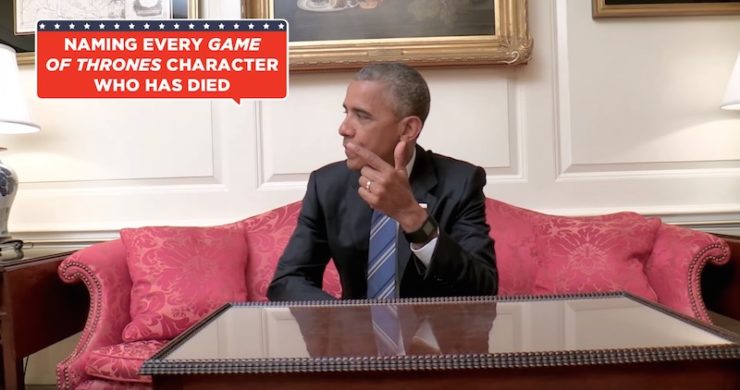
In a 2015 interview with GQ, Obama mentioned that HBO’s Game of Thrones is one of his favorite TV shows—though he admitted that his biggest problem with the series is that he can’t remember any of the characters’ names (not even his favorite, Tyrion Lannister). While Stephen Colbert poked fun at Obama for not following the fictional politics in Westeros, Obama proved that he was caught up with the show’s most pressing questions when he got a moment with one of Game of Thrones’ directors, David Nutter. As Nutter told Entertainment Weekly in 2015,
“Three weeks ago, I was the in the company of the President of the United States. He turned to me, put his hand on my shoulder, and said, ‘You didn’t kill Jon Snow, did you?’”
In fact, when season 6 rolled around in 2016, Obama was caught up before anyone else in the country: He scored copies of the episodes before HBO aired the season premiere. EW reported:
During HBO’s Facebook Live stream from the event’s red carpet, interviewer Veronica Belmont asked [showrunners David Benioff and Dan Weiss] if they had any “ah-ha … we’ve totally made it” moments coming into season 6.
“I think, for both of us, finding out the President wanted advanced copies of the episodes was an ‘ah-ha’ moment,” Weiss said. “That was a very strange moment.”
And did they say yes?
“Yes,” Weiss replied. “He’s the leader of the free world.”
Benioff added: “When the commander-in-chief says, ‘I want to see advanced episodes,’ what are you gonna do?”
He even took a stab at reciting all of Game of Thrones’ deaths for the 2015 BuzzFeed video “5 Things That Are Harder Than Registering to Vote.” Take a look:
#ReadingGoals
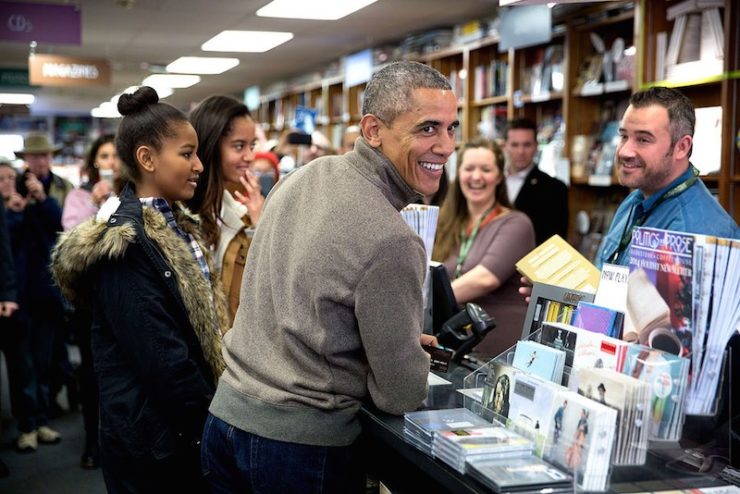
There’s epic fantasy on the president’s TV screen and science fiction by his bedside. It’s especially fitting that Obama chose Neal Stephenson’s Seveneves for his summer reading in 2016, as much of his interview with PopSci revolved around space:
PS: You’ve also advocated the development of a private space industry to work alongside and complement government efforts. What is your vision for space exploration and commercialization? Who does what?
BO: I’ve laid out a vision for space exploration where our astronauts travel out into the solar system not just to visit, but to stay. To build a sustainable human presence in space, we’ll need a thriving private-sector space economy. I see the expanding space industry as an addition to, not a replacement for, the extraordinary work of NASA. With industry taking over tasks like ferrying cargo and crew to the International Space Station, NASA can focus even more intensely on the most challenging exploration missions, like landing astronauts on Mars or learning more about Earth and the rest of our solar system.
As we set our sights toward other planets, we can also create good jobs here on this one. American companies have begun to reclaim the lucrative market for launching commercial satellites. That’s just one example of the way that a growing space economy can help American workers succeed.
With a nod to pop culture, of course:
PS: If you were to end up on Mars, who would you want as your companion: Mark Watney from The Martian, or Ellen Ripley from Alien?
BO: As long as it’s a hypothetical question, can’t I pick both? If I’ve got Matt Damon growing potatoes and Sigourney Weaver taking care of any unwelcome intruders, I like my chances.
When Obama wasn’t looking at fictional futures and alternate realities, he had his nose buried in scientific non-fiction: Elizabeth Kolbert’s compelling case for The Sixth Extinction made for light summer reading in 2016, while he rang in 2015 reading Being Mortal: Medicine and What Matters in the End by Dr. Atul Gawande.
White House Science Fairs

Obama established the tradition of White House Science Fairs in 2009, saying,
If you win the NCAA championship, you come to the White House. Well, if you’re a young person and you’ve produced the best experiment or design, the best hardware or software, you ought to be recognized for that achievement, too. Scientists and engineers ought to stand side by side with athletes and entertainers as role models, and here at the White House we’re going to lead by example. We’re going to show young people how cool science can be.
Among the 100 science, technology, engineering, and math (STEM) projects presented in 2016 (the final White House Science Fair for the Obama administration) were compostable batteries, ebola diagnostic tests, and proposed solutions for dirty water and climate change issues.
Obama’s focus on improving STEM education in America started with kids, with results among the adult population. He told PopSci,
There’s a lot to be proud of. We now graduate 25,000 more engineers per year from our colleges and universities than we did when I took office. We’re more than halfway toward our goal of preparing 100,000 new math and science teachers by 2021. We’ve secured more than $1 billion of private investment for improving STEM education, and commitments from college and university leadership to help underrepresented students earn STEM degrees. There’s also something that’s harder to measure, but every bit as important: all the young people, including minorities and young women, who are more excited than ever about pursuing their passions for STEM.
In June 2016, the administration released the list “100 Examples of Putting Science in Its Rightful Place,” echoing Obama’s pledge upon taking office.
Robots! a.k.a. White House Maker Faires
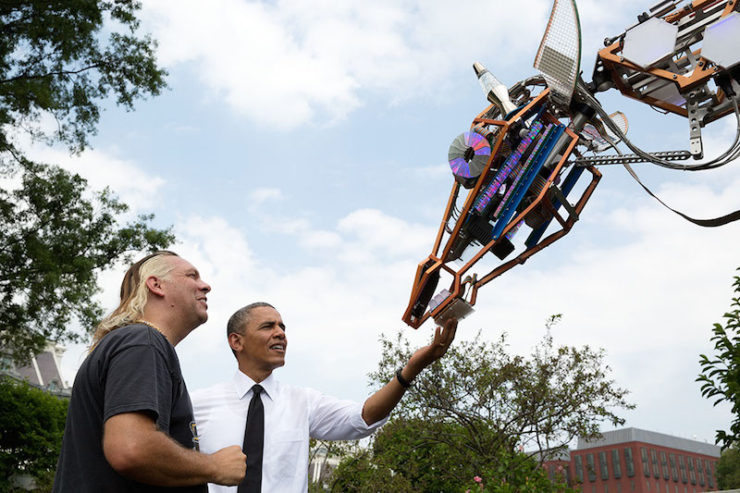
In 2014, Obama launched the Nation of Makers initiative, which kicked off with the first-ever White House Maker Faire. In addition to Lindsay Lawlor and his robot giraffe Russell (above), the White House Maker Faire and subsequent Weeks of Making each year have been host to makers with everything from cardboard dinosaurs to laser-cutting businesses to robotics companies. At 2015’s Week of Making, Obama said,
“Makers and builders and doers—of all ages and backgrounds—have pushed our country forward, developing creative solutions to important challenges and proving that ordinary Americans are capable of achieving the extraordinary when they have access to the resources they need. During National Week of Making, we celebrate the tinkerers and dreamers whose talent and drive have brought new ideas to life, and we recommit to cultivating the next generation of problem solvers.”
“Today’s D.I.Y is tomorrow’s Made in America.”
White House Astronomy Nights
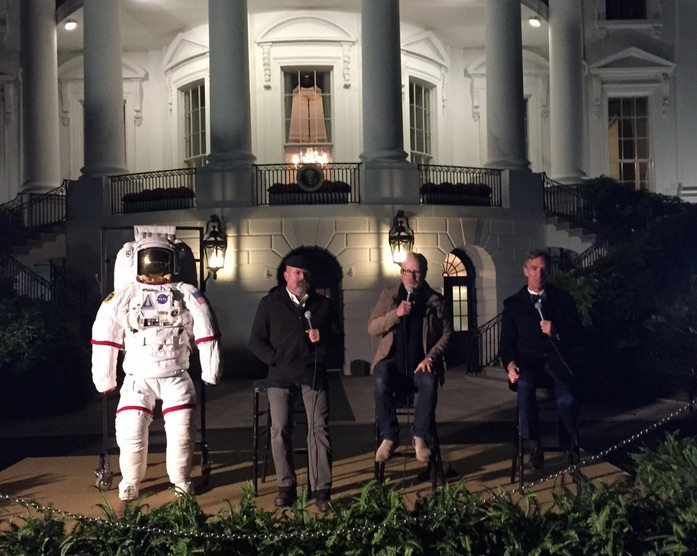
Less frequent but equally important have been the White House Astronomy Nights, which took place in 2009 and 2015. The latter’s guests included Mythbusters’ Adam Savage (who tweeted the above photo) and Jamie Hyneman and the Science Guy himself, Bill Nye. As the White House Press Office described the event:
The event will bring together scientists, engineers, and visionaries from astronomy and the space industry to share their experiences with students and teachers as they spend an evening stargazing from the South Lawn. In addition to inspiring students and stargazers from across the country to learn about the newest astronomical discoveries and the technologies that enable us to explore and live in space, we are continuing progress on the President’s call to action to expand access and opportunities for students and adults to participate in the wonders of science and space.
Obama also took the opportunity to announce a number of private-sector commitments with NASA and other organizations to further students’ interest in STEM fields.
A Farewell to Spock
It is rare for the White House to comment upon the career of a science fiction actor, and yet upon the passing of Leonard Nimoy in early 2016, President Obama wanted to make one sentiment very clear,
I loved Spock.
The president got to meet Leonard Nimoy in 2007 just before his election and,
It was only logical to greet him with the Vulcan salute, the universal sign for “Live long and prosper.”
Guest-Editing WIRED’s “Frontiers” Issue
In late 2016, Obama joined the ranks of WIRED Magazine’s guest editors, the first sitting president to do so. Like his predecessors J.J. Abrams on puzzles and Christopher Nolan on space and time, Obama chose a unifying theme for the November issue that spoke to him, as Editor-in-Chief Scott Dadich explained:
The president and his team had page after page of ideas, and we realized that many of them focused on confronting big challenges—stopping climate change, exploring Mars, using personalized medicine to cure disease. They were the kind of ambitious ideas that you can see energizing a relatively young, hopeful optimist who’s about to be out of a job. We talked about the next big hurdles humanity faces and how we will get past them. These are the things that interest us too. One word seemed to capture the mutual mood: frontiers.
Dadich went on to clarify Obama’s influence on the issue, from focusing on efforts to land humans on Mars and cure rare diseases, and an examination of Star Trek:
What guest editors do, typically, is tell us who they are and what they care about. They point us to ideas and themes and people that are meaningful to them, and we turn those thoughts into stories. We pitch the guest editor our ideas too. We try to figure out how to reconstruct the magazine itself to reflect what we’re talking about. This time, as we started that process, that theme—frontiers—kept resonating. It means something to us as individuals, and it’s central to our national narrative. So the president told us what it meant to him and gave us leads on stories and people. We asked our writers for their thoughts, and we came up with the idea of breaking the issue into the sections you’ll find within: personal, local, national, and international frontiers—and, of course, the final one, because it turns out President Obama is a big Star Trek nerd.
No, really—in the video above, he is talking about what made the series so resonant: “It wasn’t actually about technology. It was about values and human relationships.”
What’s more, President Obama co-hosted (with the University of Pittsburgh and Carnegie Mellon University) the White House Frontiers Conference in October 2016, which explored the “the future of innovation here and around the world.” The Allegheny Observatory at the University of Pittsburgh closed out the conference with a White House Frontiers Astronomy Night, inviting its attendees to look upward.
Friendship Bracelets FTW
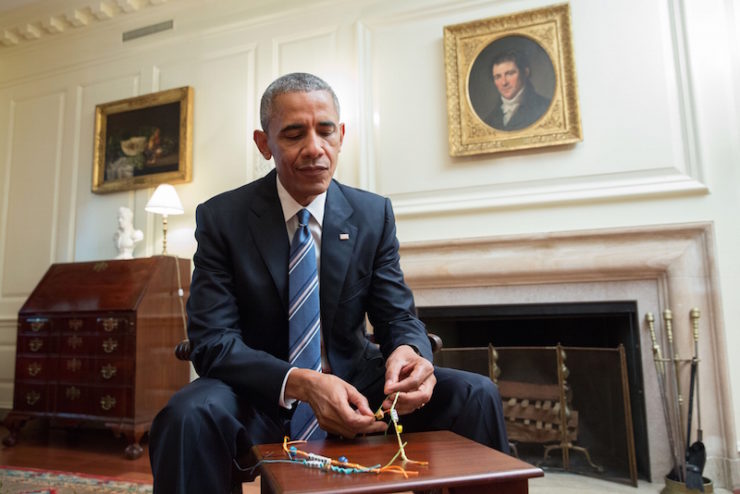
Okay, not sci-fi/fantasy-ish, but definitely nerdy: Who could forget the time that he made a friendship bracelet for his BFF Joe Biden?










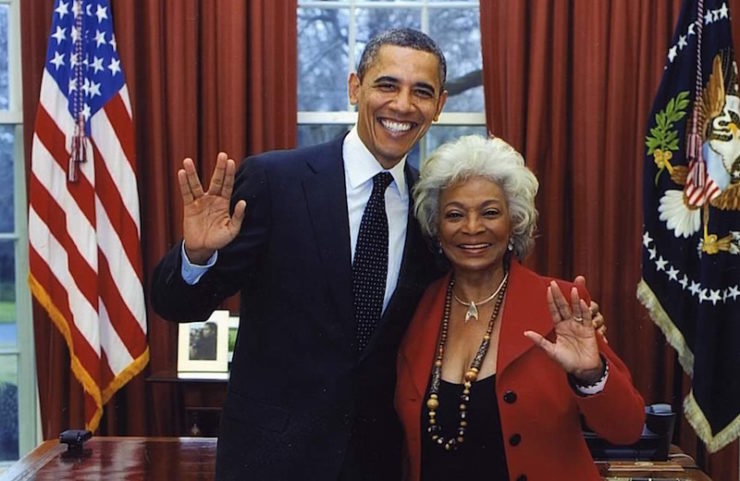
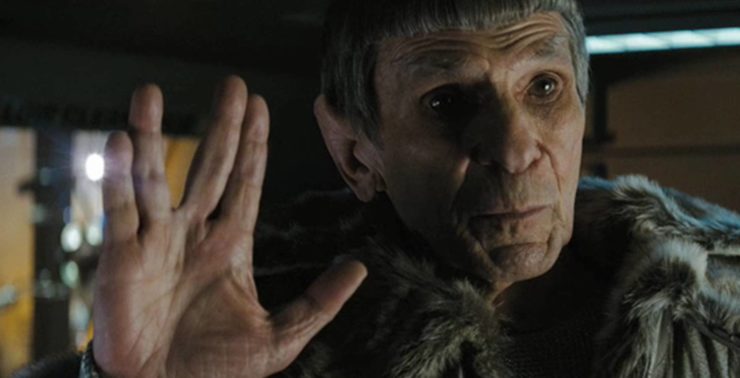
Appropriating a pejorative word is just as insulting as using it in its original meaning.
Hi, all–let’s try to keep the discussion related to the points covered in the post, and maybe keep in mind the positive spirit in which it was intended. Thanks.
I can definitely say that I’ll miss President Obama. No, he isn’t perfect, but he’s extremely smart and seems to care about many different kinds of people. I’m not sure if his successor can say the same.
I think it’s great to see a leader of one of the most powerful/influencial countries in the world being shown to be “with it”, and one that relates to the younger crowd. What’s wrong with being portrayed as having fun, and being a little “nerdy”, etc.? I also like to see the reading lists (I have at least a few of the same books in my TBR pile (bookshelf)). Especially like to see someone like a US President promoting reading (for fun).
You didn’t mention my favourite geeky moment:
he keeps an eye on the robots, guarding against the AI Uprising…
https://www.theatlantic.com/politics/archive/2011/06/quote-did-obama-just-predict-skynet/352154/
A great tribute to one of Obama’s signal contributions to the nation–making science nerds cool! I would love this post even if didn’t have my two favorite photos of Obama: the one with Nichelle Nichols and the one at the White House Science Fair. Thanks!
I’ve always had a great deal of respect for him. But I had no idea he was a nerd/geek. Now I have even more respect for him.
Live long and prosper, Prez Obama!
I liked the things he did to promote science and engineering. And while he was probably not the first U.S. President to read comic books, I think he is the first to go into detail about how much he enjoyed them and how they shaped his thinking as a youngster–as I recollect, his favorites were Spider-Man and Conan. He certainly exhibited more knowledge of comics than he did of baseball; I’ll never forget that when asked to name a favorite player on his supposedly favorite team, the White Sox, he drew a blank!